Overnight Sourdough Bread
This post may contain affiliate links.
If you are looking for an overnight sourdough bread recipe that can be bulk fermented overnight, then you've come to the right place.
This easy sourdough bread recipe uses a smaller amount of starter to ensure your dough doesn't over ferment while you sleep. There are a few other things that you will need to do to successfully bake overnight sourdough bread and I've put together all the best tips and tricks in this post!
This simple overnight sourdough bread recipe is based on my simple sourdough bread recipe that has helped thousands of beginner bakers launch their sourdough journey! You'll need an active sourdough starter to make this delicious sourdough bread.
If you are a beginner, I highly recommend reading through that post, as well as through the Sourdough FAQs here.
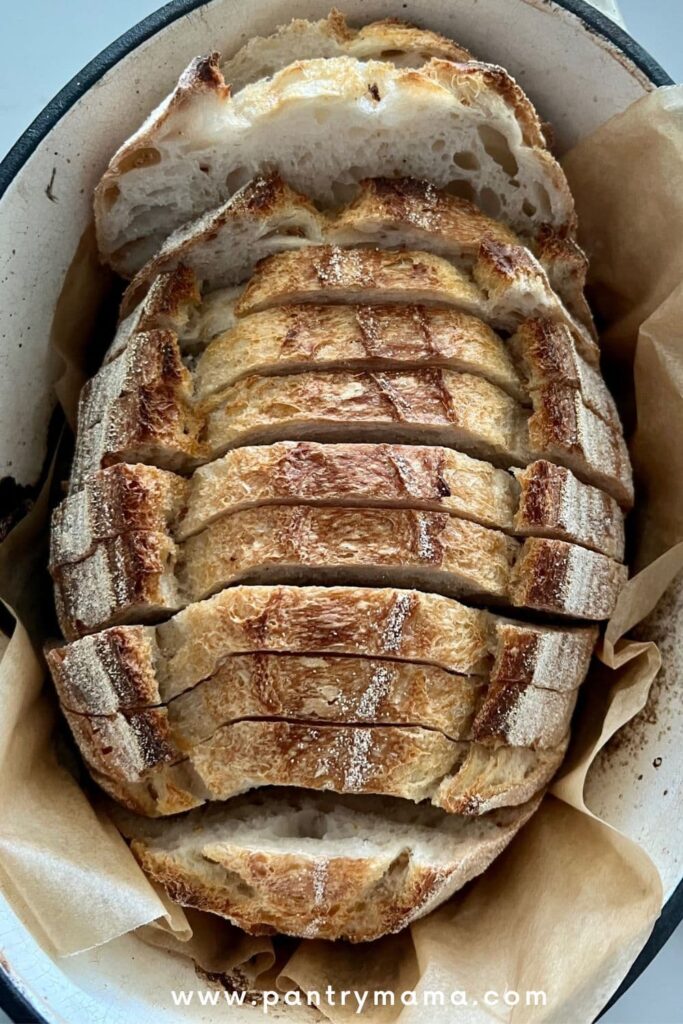
What Does Overnight Sourdough Bread Even Mean?
When you hear the term "overnight sourdough bread" you might wonder what the "overnight" is actually referring to? The overnight refers to the fact that you mix the dough in the late evening and leave it to ferment on the counter overnight while you sleep. You then wake up and shape the dough.
You could choose to place the shaped dough in the fridge and bake the following evening, or do a shorter counter proof and bake the same morning.
This timeline won't work for everyone, but it is a very handy timeline if you work full time and are not home during the day to be able to make sourdough bread.
I've included a baking timeline to help you facilitate the overnight bulk fermentation further down.
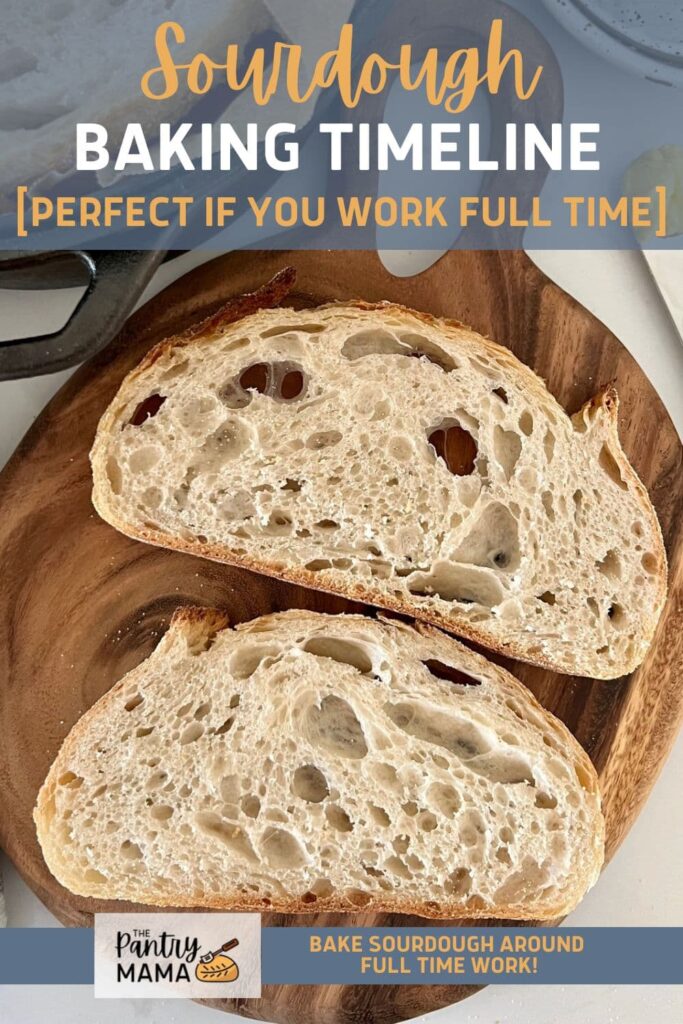
Can You Let Sourdough Bread Rise Overnight?
You can absolutely leave sourdough bread to rise overnight - but as always - there are some things you'll need to do to make sure that your bread is successful with an overnight ferment.
The most important things you need to adjust for successful overnight fermentation are:
- the amount of sourdough starter you use - you need to use a smaller amount of starter to ensure that your bread does not over ferment when being left out overnight. I recommend 10% or in this recipe 50g.
- the temperature you're leaving your dough at - I recommend not leaving your dough out overnight if the room temperature in your home is more than 21C (69.8F). If your room temp is higher than this, you'd need to reduce the starter amount further or try to find a cooler spot.
Sourdough rise, also known as bulk fermentation, can be tricky to get right.
But understanding bulk fermentation and being able to leave sourdough to rise overnight can be an absolute game changer! You should also understand the differences between bulk fermentation and cold fermentation.
Where Do I Get A Sourdough Starter From?
This recipe requires an active sourdough starter that's been recently fed. If you don't already have a sourdough starter, you could choose to make one using these sourdough starter instructions.
Alternatively, you might like to ask a friend to share their sourdough starter or even buy one from a reputable source. I've put together a guide to buying a sourdough starter here.
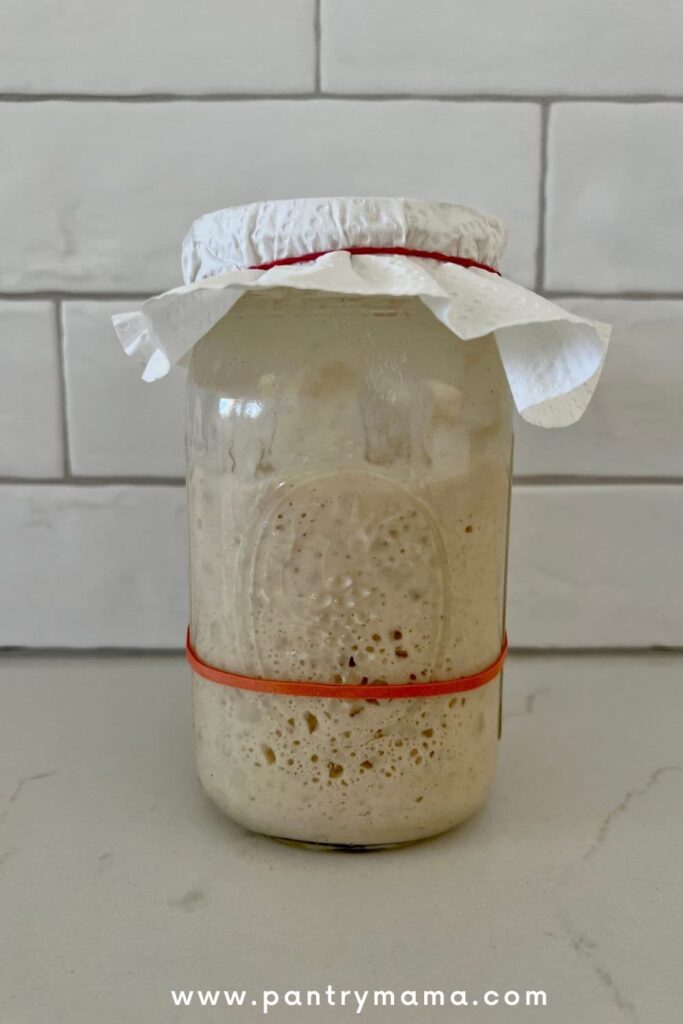
How To Make Overnight Sourdough Bread (step by step instructions)
Making overnight sourdough bread is really a simple process. There are a huge amount of instructions, however the "hands on dough" time is relatively low.
I encourage you to read through the whole process though, so you're familiar with it before starting your dough.
Remember sourdough is a very forgiving process!
Autolyse (Premixing the Dough)
Weigh out your sourdough starter and water into a large mixing bowl - whatever you have in the cupboard is fine!
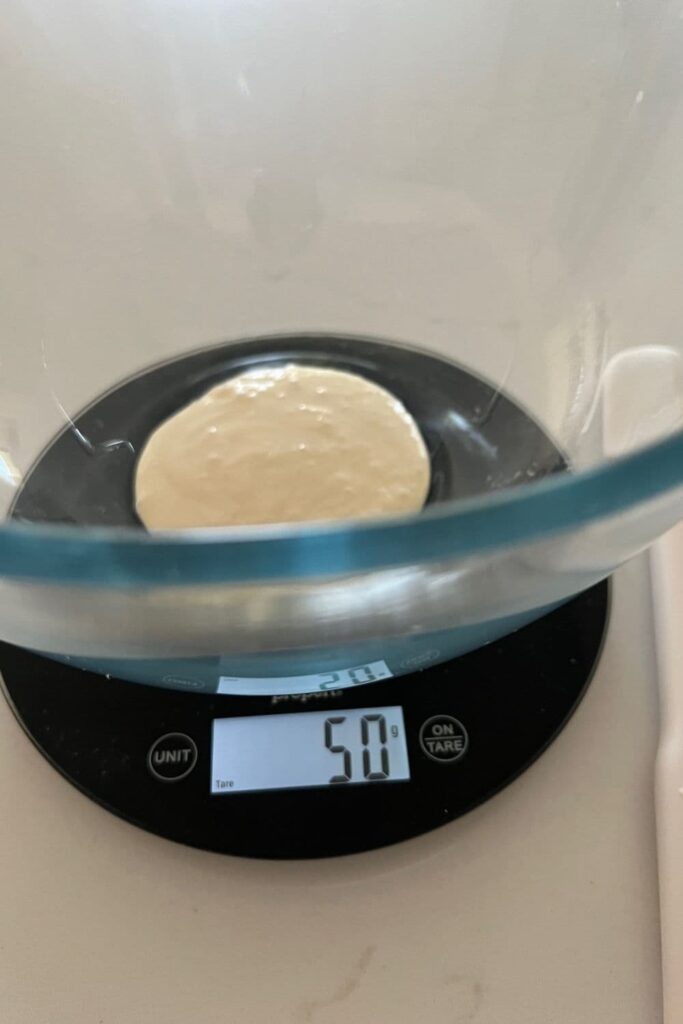
Mix the water and starter together briefly. Then add your flour and salt and mix whole lot together to form a shaggy dough.
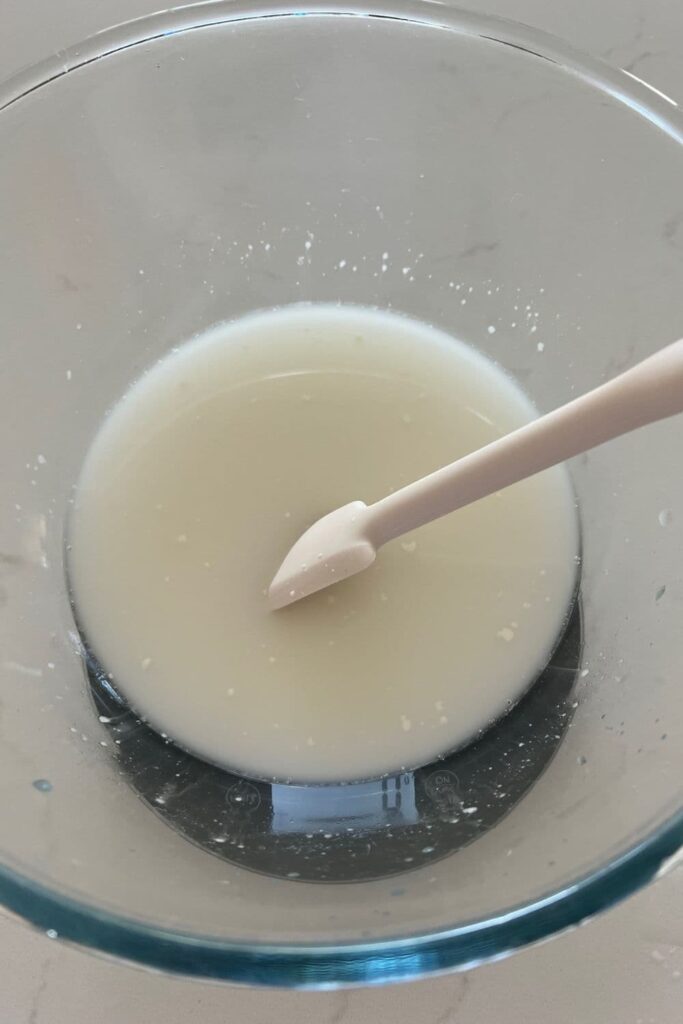
The dough will be fairly shaggy and only just brought together (see photo). You might wonder how this will turn into bread, but just wait, time is your friend and the dough will change in around an hour.
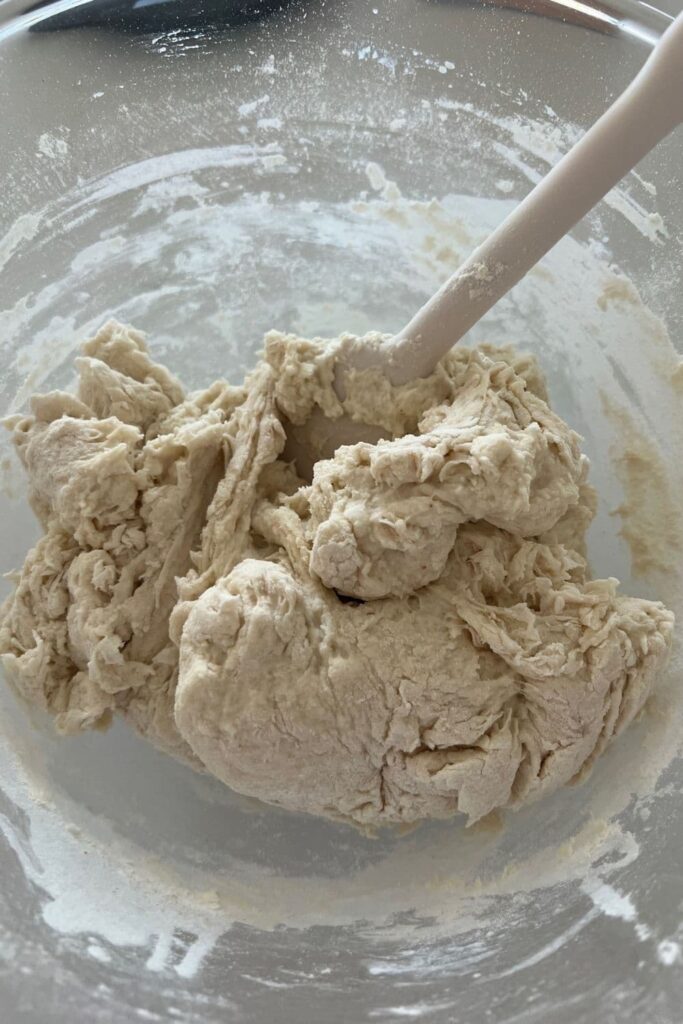
Cover your bowl with an elastic food cover or plastic wrap and let it sit for around 1 hour. It's ok if it's a little bit longer, it's not going to matter too much.
This process is called the "autolyse" and allows your flour to soak in all the water and become hydrated.
Forming Up The Dough
After the dough has been through autolyse you need to bring it together into a ball. Work your way around the bowl, grabbing the dough from the outside, stretching it up and over itself, into the centre, until a smooth ball is formed.
You shouldn't need more than about 20-25 stretches to form the ball. You'll notice that the dough is fully hydrated after soaking all the water up. It will be fairly sticky but the dough will strengthen as you move through the process.
Once the dough has formed into a ball, pop the cover back on and let it rest for 30 minutes.
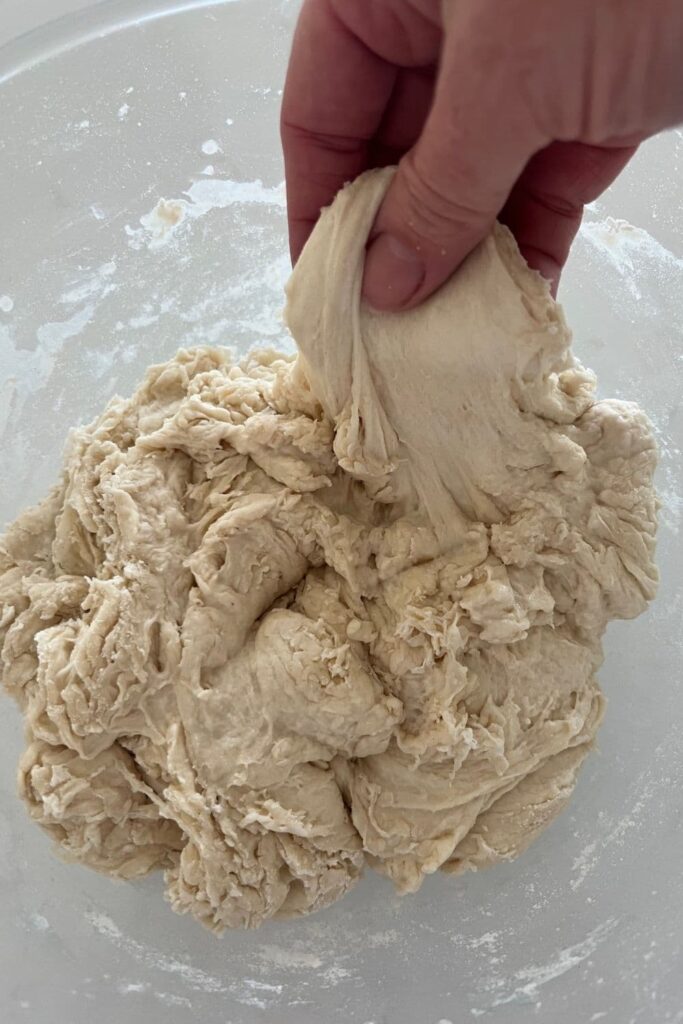
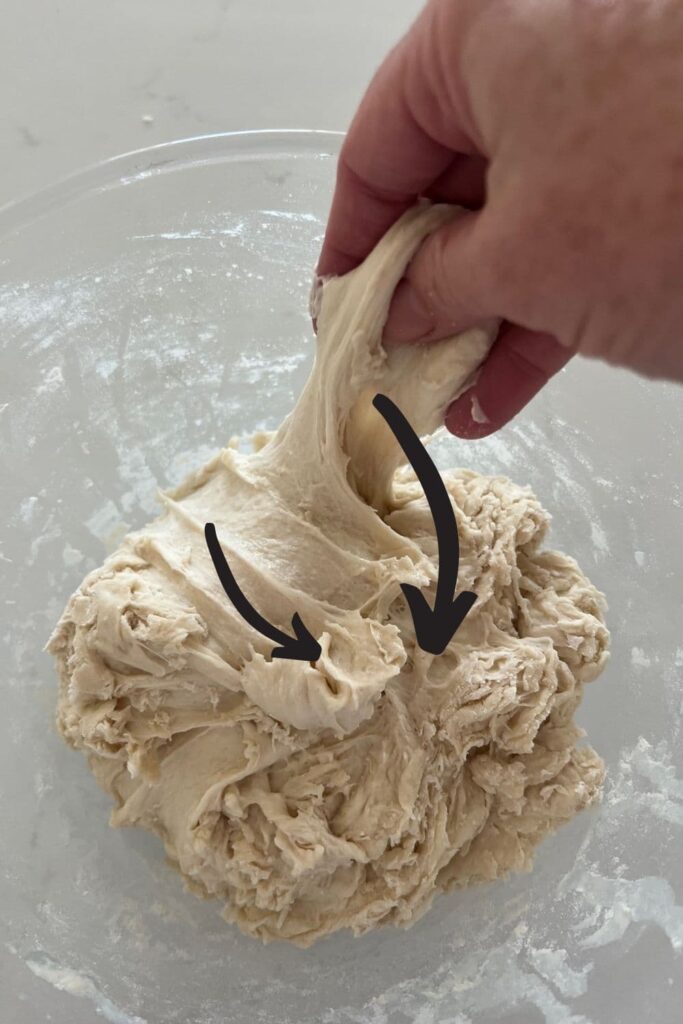
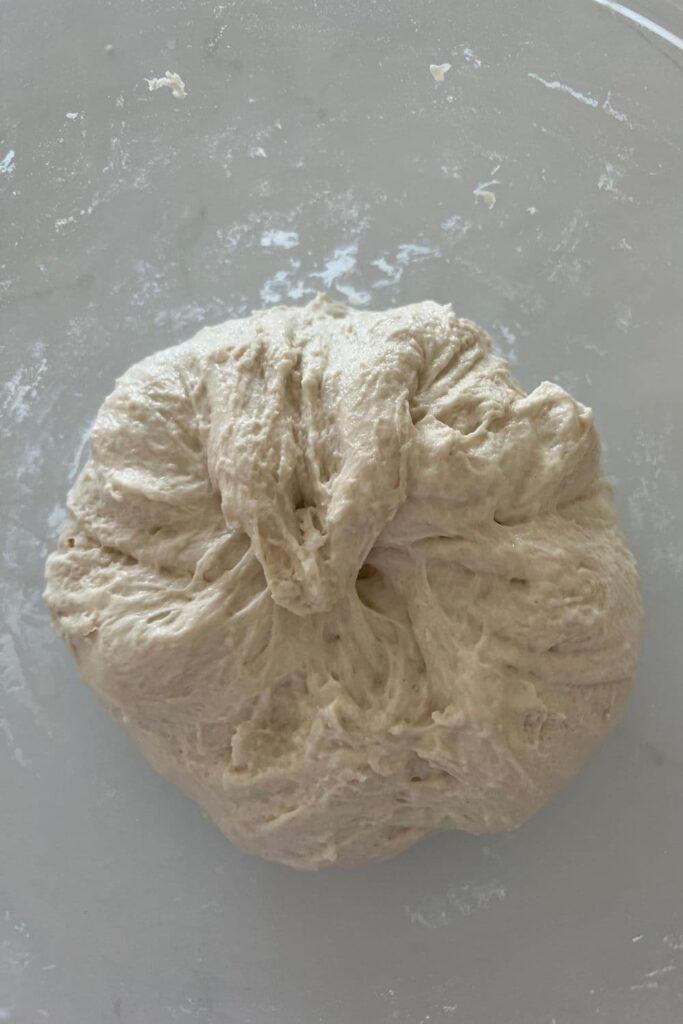
Stretch & Fold - Creating Structure
Over the next few hours you need to create some structure for your dough by "stretching and folding".
Aim to do around 4-6 sets of stretches and folds.
For each set, stretch the dough up and over itself 4 times. Leave around 15 minutes in between each set. Again you do not have to be exact with time, but you need to do at least 4 sets over 2 hours.
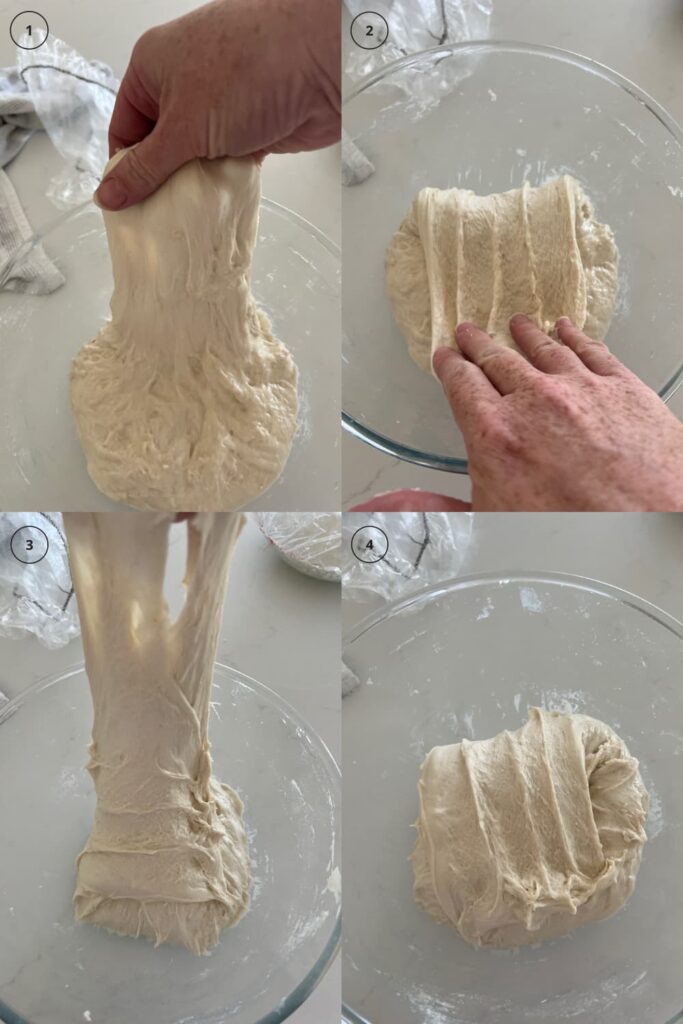
Bulk Ferment
Once you've finished your stretch and folds, cover the dough with a plastic cover (a recycled plastic bag is perfect) and allow the dough to double overnight (I have included a sample timeline further down).
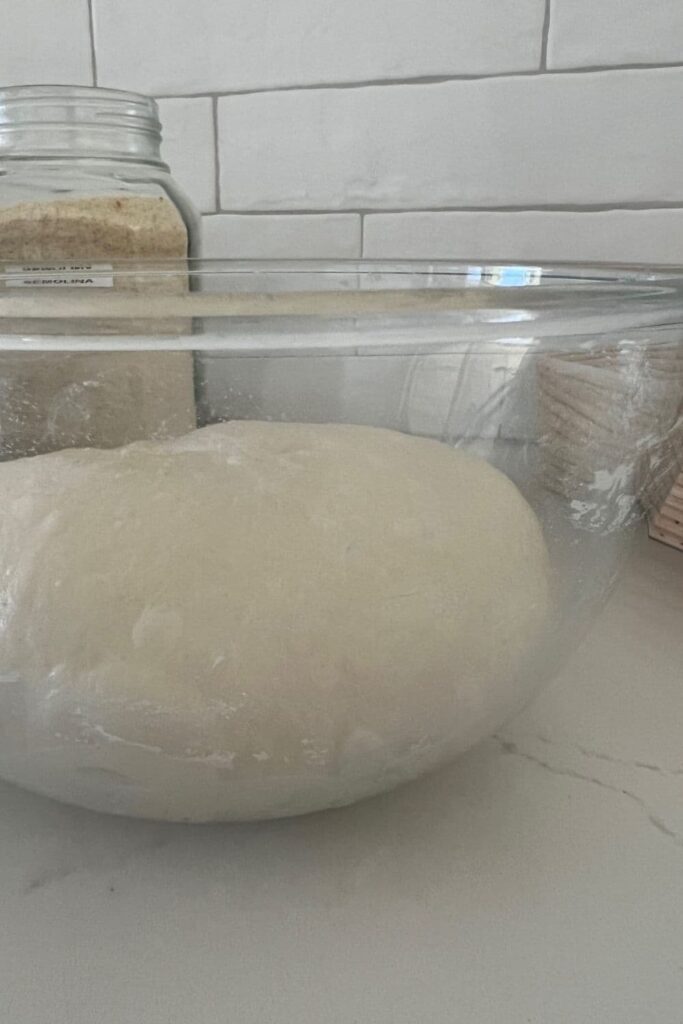
Shaping The Dough
Once your dough has finished its first ferment, it's time to shape it into either a boule or a batard.
You'll need to flour your counter top with rice flour for this (we use rice flour because it has no gluten). Try to be quite sparing with the rice flour, you only need a very light dusting.
Use a dough scraper to gently ease the dough out of the bowl (your hands work just fine if you don't have one). You want it to land upside down on your counter so that the smooth top of the dough is on the countertop and the sticky underside is facing up.
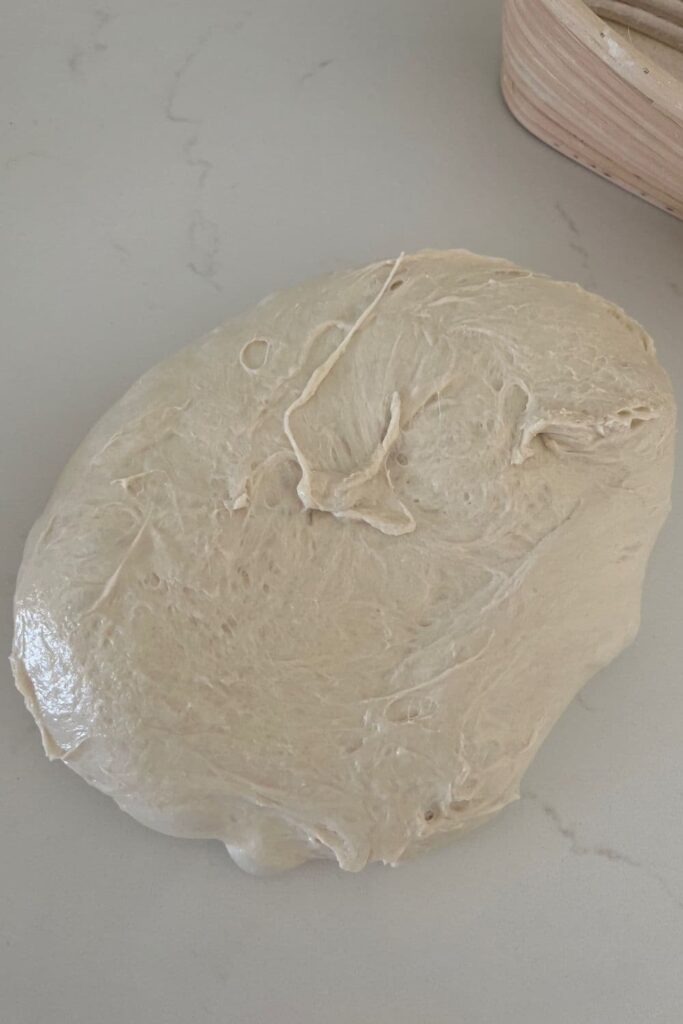
Shape your dough into whatever shape works best for you. I have shaped this overnight sourdough bread into a batard (full shaping video here).
You will need a proofing basket or container to put your dough into. You can find more notes on what to use as a banneton here.
Whatever you're using needs to be liberally floured with your rice flour (or corn meal or semolina).
Placing Into A Proofing Container
Once the dough is shaped into a tight ball, place it into your proofing basket or container smooth side down, so your seam is on the top.
If you're using a cloth or tea towel in a bowl it's ok to put your dough with the smooth side up. Just make sure the dough is tight. Lift your dough around the edges to pop a little more rice flour if you feel it needs it. Just try to handle the dough as little as possible and be really gentle as you really want to preserve all the gases and air bubbles that have formed during your bulk ferment.
Please note the dough in this photo has been sprinkled with semolina rather than rice flour (it works in the same way to stop the dough sticking to the banneton).
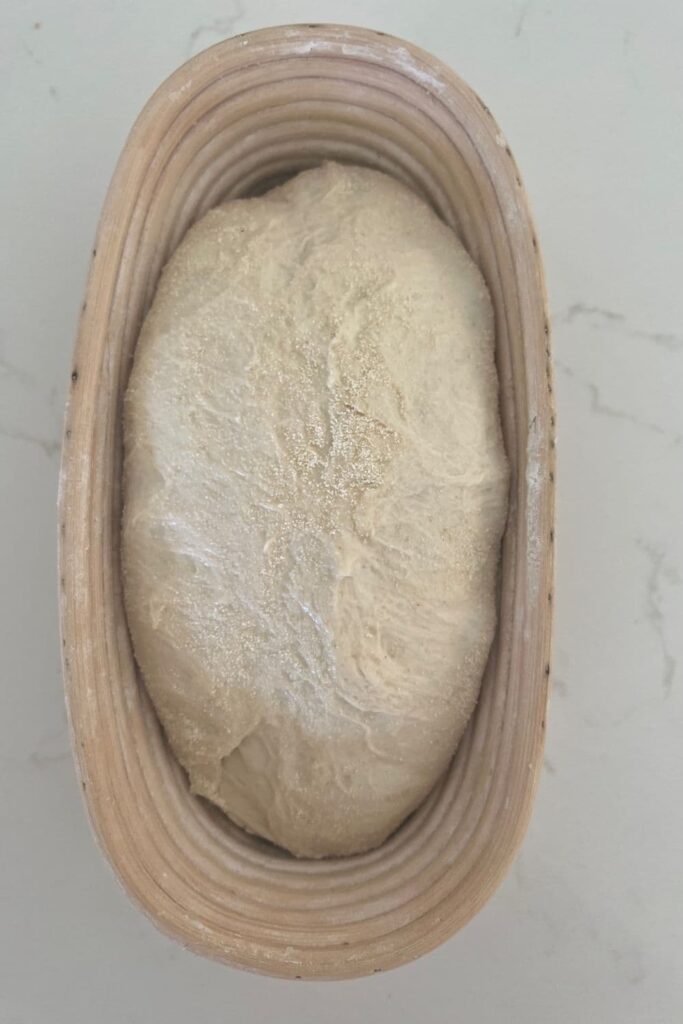
Cold Ferment (optional)
Now the dough is in its "shaping container" cover it loosely with a plastic bag and place into the fridge.
I use a large plastic bag to cover it - I just reuse it each time.
Try to leave it in the fridge for a minimum 5 hours. If you're following my timeline below, you'll leave it in the fridge for around 10 to 11 hours.
Counter Proof
If you don't want to put the dough in the fridge for a cold ferment, you can leave it to proof on the counter for a little while. You do need to be careful not to let it over ferment. Ideally, you want the temperature to be on the cooler side (no more than 21C / 69.8F). Let the dough relax into the banneton.
Preparing to Bake Overnight Sourdough Bread
Once you're ready to bake your sourdough, you'll need to preheat your oven to 230C/450F. Place your Dutch Oven into the oven when you turn it on so it gets hot.
Leave your dough in the fridge (or counter) until the very last minute - placing a cold dough into a hot oven will give you a great "spring".
When your oven is at temperature, take your sourdough out of the fridge. Gently place it onto a piece of parchment paper or silicone sling if using.
Gently score your bread with a clean razor blade or knife. At minimum a large cross is sufficient, but you can get as artistic as you like. You can find my full guide on how to score sourdough bread here.
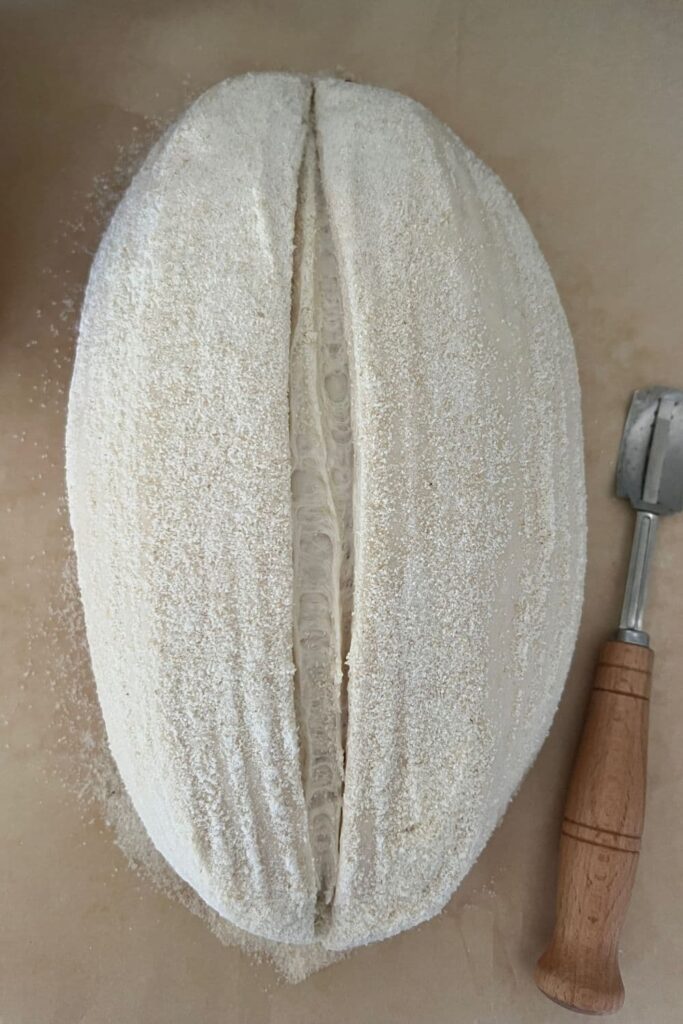
Carefully take your dutch oven out of the oven. Place the sourdough into the pot using the silicone sling or parchment paper as a handle. Put the lid on and place into the hot oven.
If you want to you can spritz your dough with extra water before you put the lid on.
BAKE TIME:
30 Minutes with the lid on at 230C/450F plus
10-15 Minutes with the lid off at 210C/410F

Finishing The Bake
When you remove your dough from the oven, carefully remove it from the oven as soon as possible and place on a wire rack to cool.
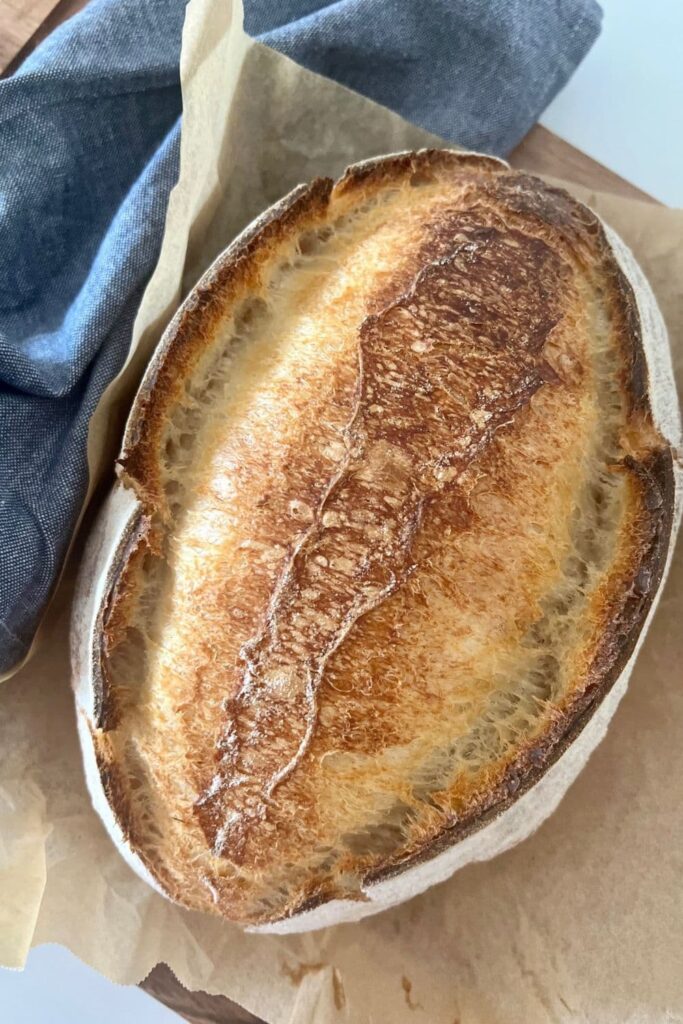
Baker's Timeline for Overnight Sourdough Bread (perfect if you work full time)
This sample baker's timeline for making overnight sourdough bread is perfect if you're out of the house most of the day. It utilises your sleeping time to ferment the sourdough bread.
You don't have to do the cold ferment, you could bake it that morning, but if you like the extra flavor the cold ferment brings, you can bake it when you get home for the evening.
DAY 1
7.00am - Feed sourdough starter (1:2:2 to ensure delayed peak)
6.00 pm - Premix and Autolyse (while I cook dinner)
7.30pm - Form into a smooth ball. Rest for 30 minutes.
9.00pm - Perform 4-6 sets of stretch & folds over next 2 hours.
11.00pm - Cover and leave on bench overnight for bulk ferment (temp needs to be less than 21C).
DAY 2
7.00am - Shape & lift into banneton/bowl & into the fridge.
6.00pm - Bake your sourdough!
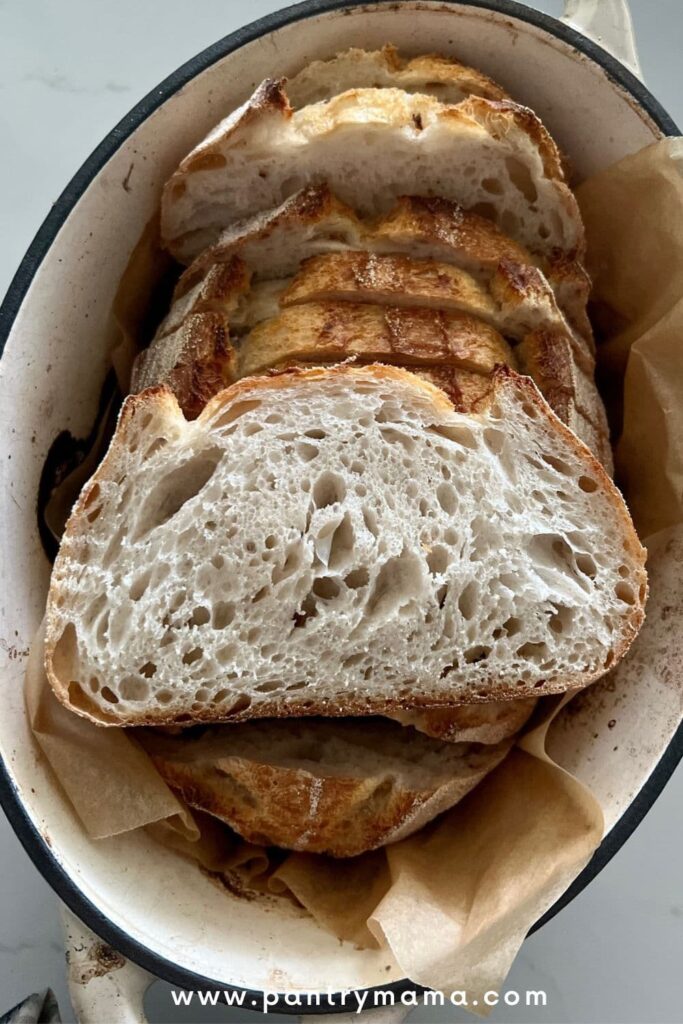
What Equipment Do I Need?
Having the right equipment can make baking sourdough bread much easier and give you more consistent results. Of course, if you're just starting out and don't want to spend a lot of money, you can use what you have at home already (my budget sourdough recipe has lots of great tips for doing this).
For the best results, I highly recommend having:
- Glass mixing bowl so you can watch all the action unfold.
- Kitchen scales so you can accurately measure ingredients.
- Silicone dough scraper to get the dough out of the bowl without losing the precious bubbles.
- Stainless steel bench scraper for easy sourdough shaping.
- Banneton for retaining shape while cold proofing.
- Bread Lame for perfect scoring - check out my guide on how to score sourdough bread here.
- Dutch oven to ensure you get the best possible oven spring and crust.
- Good quality bread knife to ensure easy & consistent slicing of my sourdough bread.
Frequently Asked Questions
You absolutely can leave your sourdough starter out overnight after feeding it, particularly if you are going to bake with it the next day. I highly recommend feeding it a higher ratio to prolong it's peak and ensure that it's ready for the you in the morning.
If you let sourdough sit out too long, whether it's during bulk fermentation or during proofing, it will over ferment and turn into a soupy mess. Dough that has over fermented is runny, sticky and very hard to shape. It will collapse when scored and be very disappointing.
You can cold ferment or cold proof your sourdough overnight because the cold temperature of the fridge stops the dough from over fermenting. If you were to leave your shaped dough on the counter overnight, you'd wake up to a soupy mess (unless it was freezing in your home). It's important to note the different types of fermentation when making sourdough bread.
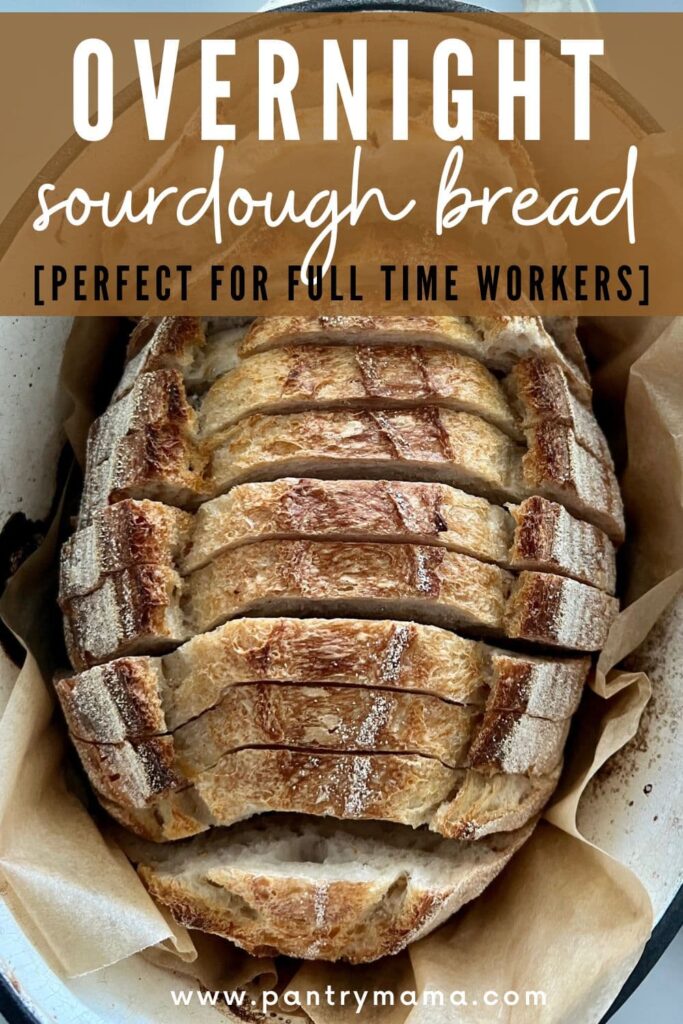

Overnight Sourdough Bread Recipe
Equipment
- Basic Kitchen Scale (grab them for as little as $10 here)
- Mixing Bowl
- Dutch Oven
Ingredients
- 500 g Bread Flour 100%
- 350 g Water 70%
- 50 g Sourdough Starter 10% (Fed and Bubbly)
- 10 g Salt 2% (increase or decrease according to your taste)
Instructions
- Autolyse - Premixing The DoughWeigh out your sourdough starter and water into a large mixing bowl - whatever you have in the cupboard is fine!Glass is always good as you can see what's happening underneath your dough. But any plastic, ceramic, stainless steel or glass bowl is fine! Mix the water and starter together briefly. Then add your flour and salt and mix whole lot together to form a shaggy dough. The dough will be fairly shaggy and only just brought together (see photo). You might wonder how this will turn into bread, but just wait, time is your friend and the dough will change in around an hour.
- Cover your bowl with an elastic food cover or plastic wrap and let it sit for around 1 hour. It's ok if it's a little bit longer, it's not going to matter too much.This process is called the "autolyse" and allows your flour to soak in all the water and become hydrated.
- Forming Up The DoughAfter the dough has been through autolyse you need to bring it together into a ball. Work your way around the bowl, grabbing the dough from the outside, stretching it up and over itself, into the centre, until a smooth ball is formed. You shouldn't need more than about 20-25 stretches to form the ball.You'll notice that the dough is fully hydrated after soaking all the water up. It will be fairly sticky but as you bring it into a ball, it will become smoother and shinier.
- Once the dough has formed into a smooth ball, pop the cover back on and let it rest for 30 minutes.
- Stretch & Fold - Creating StructureOver the next few hours you need to create some structure for your dough by "stretching and folding". Aim to do around 4-6 sets of stretches and folds. For each set, stretch the dough up and over itself 4 times. Leave around 15 minutes in between each set. Again you do not have to be exact with time, but you need to do at least 4 sets over 2 hours.
- Bulk FermentOnce you've finished your stretch and folds, cover the dough with a plastic cover (a recycled plastic bag is perfect) and allow the dough to double overnight (I have included a sample timeline for you to follow so that you can bulk ferment overnight in the post above).
- Shaping The DoughOnce your dough has finished its first ferment, it's time to shape it into either a boule or a batard. You'll need to flour your counter top with rice flour for this (we use rice flour because it has no gluten). Try to be quite sparing with the rice flour, you only need a very light dusting.Use a dough scraper to gently ease the dough out of the bowl (your hands work just fine if you don't have one). You want it to land upside down on your counter so that the smooth top of the dough is on the countertop and the sticky underside is facing up. This will make it easier to shape.You want to pull the edges of the dough into the centre and then flip it over so that the sticky side is now underneath. Using the stickiness, gently pull the dough into a tight ball.You will need a proofing basket or container to put your dough into. You can find more notes on what to use as a banneton here.Whatever you're using needs to be liberally floured with your rice flour.
- Placing Into A Proofing ContainerOnce the dough is shaped into a tight ball, place it into your proofing basket or container smooth side down, so your seam is on the top.If you're using a cloth or tea towel in a bowl it's ok to put your dough with the smooth side up. Just make sure the dough is tight.Lift your dough around the edges to pop a little more rice flour if you feel it needs it. Just try to handle the dough as little as possible and be really gentle as you really want to preserve all the gases and air bubbles that have formed during your bulk ferment.
- Cold Ferment (optional)Now the dough is in its "shaping container" cover it loosely with a plastic bag and place into the fridge. I use a large plastic bag to cover it - I just reuse it each time. Try to leave it in the fridge for a minimum 5 hours. If you're following my timeline above, you'll leave it in the fridge for around 10 to 11 hours.Counter ProofIf you don't want to put the dough in the fridge for a cold ferment, you can leave it to proof on the counter for a little while. You do need to be careful not to let it over ferment. Ideally, you want the temperature to be on the cooler side (no more than 21C). Let the dough relax into the banneton (no more than 2 hours).
- Preparing to BakeOnce you're ready to bake your sourdough, you'll need to preheat your oven to 230C/450F. Place your Dutch Oven into the oven when you turn it on so it gets hot. Try to preheat for around 1 hour to ensure your oven is super hot - but you know your oven so just adjust this time if you need to.Leave your dough in the fridge (or counter) until the very last minute - placing a cold dough into a hot oven will give you a great "spring".When your oven is at temperature, take your sourdough out of the fridge. Gently place it onto a piece of parchment paper or silicone sling if using. Gently score your bread with a clean razor blade or knife. At minimum a large cross is sufficient, but you can get as artistic as you like. You can find my full guide on how to score sourdough bread here.Carefully take your dutch oven out of the oven. Place the sourdough into the pot using the silicone sling or parchment paper as a handle. Put the lid on and place into the hot oven. If you want to you can spritz your dough with extra water before you put the lid on.BAKE TIME:30 Minutes with the lid on at 230C/450F plus10-15 Minutes with the lid off at 210C/410F
- Finishing The BakeWhen you remove your dough from the oven, carefully remove it from the oven as soon as possible and place on a wire rack to cool.
Notes
- Notes on Flour: This recipe is written using strong Bread Flour. Bread flour has a higher protein content than All Purpose flour. If you choose to use All Purpose flour you may have a different result because of this. You can read more about the differences between All Purpose Flour and Bread Flour here.
- Notes on Sourdough Starter: This recipe is based on you having an active starter that you have fed a few hours before starting your bake. For info on how to make a sourdough starter, go here.
- Notes on Stretch & Folds: If you are going to do the stretch & folds on your bench top, spray your surface with water mist rather than using flour. You can leave the dough in the bowl if you want to. Wet your hands to stop the dough sticking - although it shouldn't be too sticky. It will get less sticky as you do your stretches and folds. For more information on how to do stretch and folds, go here.
- Notes on Bulk Fermentation: If your home is warm then your dough will ferment a lot faster and could be done in as little as a few hours. If it's colder, it will take longer. I recommend using this overnight sourdough bread recipe in cooler temperatures, as if it's too warm the dough will over ferment while you're sleeping and you'll wake up to a bowl of soupy dough!
You will know your dough is ready to move to the next stage when it has *just* doubled in size. It will be fairly wobbly and full of bubbles. You should be able to see large air bubbles under the surface of the dough.
You don't want to let it go any further than doubled as it will be over fermented.
If you want to do an overnight ferment, but your home is warm, consider using a little less starter (ie 25g).
Less starter means your dough will take longer to ferment and you will reduce the risk of over fermenting your dough. You'll find more information on these topics here:
When is my bulk ferment finished? What is the difference between cold ferment and bulk ferment? Why does the amount of starter matter?
- Notes on Baking: If you're worried about the base of your bread burning, place a baking sheet on shelf underneath your Dutch Oven - it works! If you're worried about your bread not being cooked all the way through, turn the oven off and place your dough straight onto the oven rack. Leave the door ajar and let your bread rest there for a few hours. Make sure you don't close the door or your sourdough will sweat and you'll get a wrinkly, soggy crust. Remember not to cut into your loaf too soon - you'll need to let it cool for at least a few hours (4-6 is best).


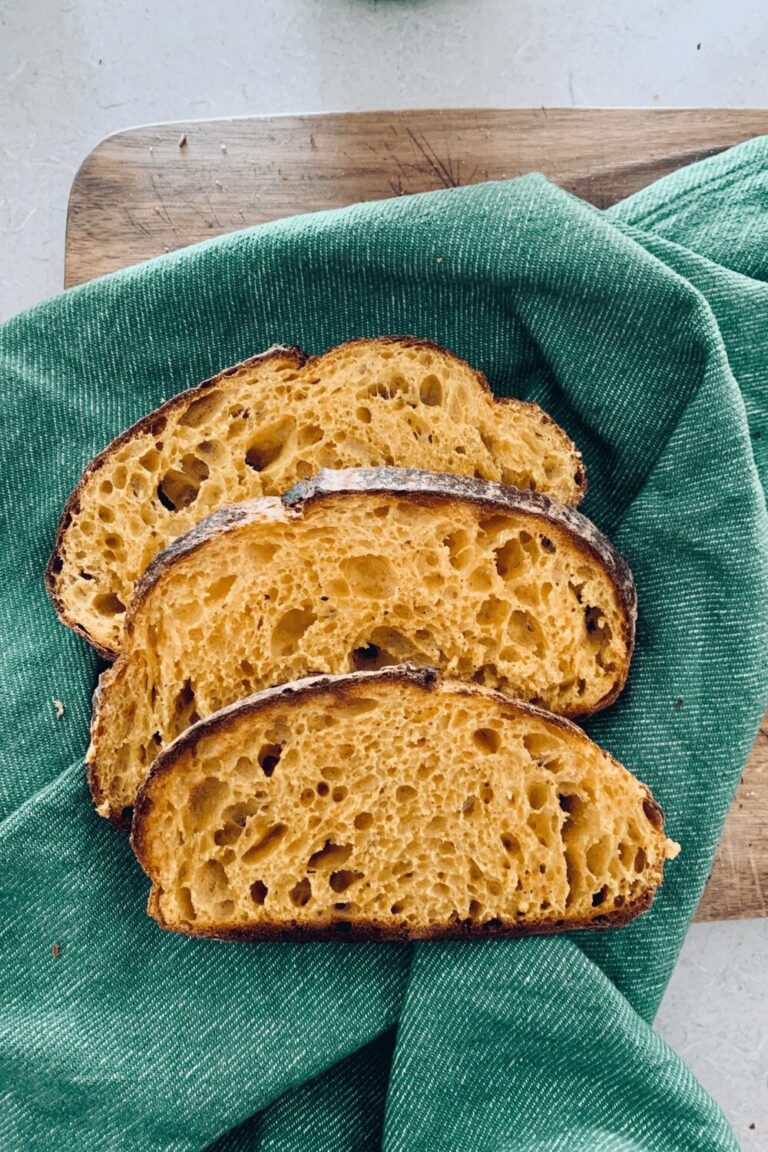



this is the BEST BREAD I have ever made in my whole sourdough making life! it was so soft and delicious! I'm trying to lose weight and count my calories but I'm confused with your nutrition panel. is it saying 100g of bread is 1,851 calories? regardless of the answer, which sounds unbelievable to me, since that's more than my whole calorie allowance for the whole day...
I'm so glad you love the recipe Emily. For some reason, it's giving you the calories for the whole loaf, I'll try and fix it. It's always best to weigh your slices and do the calculation 🙂 But yay! I'm so glad you found your go to recipe 🙂 xx
Hi there Kate! I began my Sourdough journey in 2020 and then stopped in 2022. I started again in October. I had a very lively starter at peak yesterday evening and I needed an overnight solution and found you! What a slice of luck! I decided to doing an open bake batard on a marble slab I bought in 2021. Apart from not closing off the ends properly when I shaped the dough it turned out superbly. Best loaf since I returned. I will definitely use this approach again.
Many thanks
James